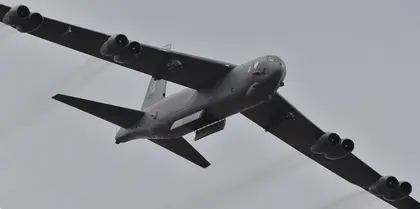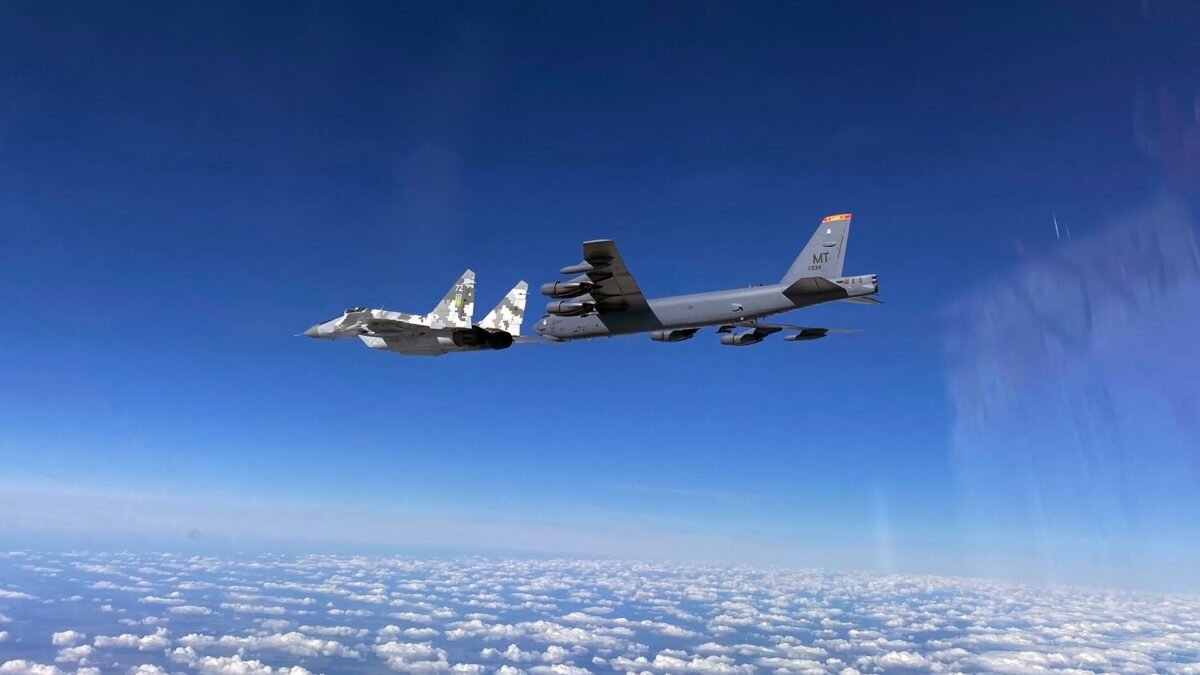The Ukrainian skies on Sept. 4 welcomed rare and magnificent guests — three U.S. Air Force strategic bombers Boeing B-52H Stratofortresses carried out an observation flight over the country’s territory studying Russia’s military activity in occupied Crimea and the Black Sea.
According to the aviation tracking website AirNav RadarBox, the legendary bombers took off from the military airfield of Fairford in the United Kingdom at 7.29 a.m. local time and entered the Ukrainian airspace close to the city of Volodymyr-Volynskiy.
- Read the most current war in ukraine update from the Kyiv Post's daily news updates today.
- Read the newest Ukraine news stories published today.
JOIN US ON TELEGRAM
Follow our coverage of the war on the @Kyivpost_official.
At midday, the aircraft did multiple circles over the Azov Sea coastline near the city of Melitopol just northeast of Russian-occupied Crimea and then took a reverse course approximately at 2.30 p.m. Ukrainian time.
According to Ukraine’s Air Force, the bombers were escorted by Ukrainian jet fighters Sukhoi Su-27 and Mikoyan MiG-29.
Notably, the flyover took place shortly before the start of Russia’s major military maneuvers Kavkaz-2020, during which the Kremlin plans on engaging over 100,000 troops in occupied Crimea and southern Russia.
The visit across the Ukrainian airspace was carried out as part of the U.S. Air Force’s now-regular strategic observation missions in the aquatic areas of the Black and the Baltic seas.
As recently as on Aug. 28, six B-52s from Minot Air Force Base in North Dakota flew over 30 NATO nations in one day, in demonstration of U.S. military power amid ongoing tensions with Russia.
In late May, Ukrainian fighters also accompanied another two U.S. strategic bombers, Rockwell B-1 Lancer, in their observation mission across the Ukrainian airspace and the Black Sea.
The B-52 family entered service as far back as in 1955, as the Cold War’s ultimate strategic bomber capable of delivering nuclear weapons within the combat range of over 14,000 kilometers without refueling. The concept turned out so successful and long-lasting that the Stratofortresses and their numerous modification even today remain in active use by the U.S. military and NASA, despite the availability much younger Rockwell B-1 Lancers and stealth Northrop Grumman B-2 Spirit.
Despite their taste for nukes, they dropped only conventional bombs during their numerous wars worldwide.
According to the U.S. military, the B-52s are expected to be operated until the 2030s, while the last aircraft expected to stay around the very 2050s. This would mean incredible 100 years in active service, which is unprecedented for any aircraft type.
Notably, in 2017, the legendary bombers were again put on around-the-clock combat alert by the U.S. Air Force — for the first time since the fall of the Soviet Union in 1991.
The observation missions in Eastern Europe on a regular basis result in bald brawls with Russians in international airspace. As recently as on Aug. 31, three Russian Sukhoi Su-27s again convoyed three B-52Hs over the Baltic Sea, with one Russian fighter violating the Danish airspace.
NATO and U.S. Air Force called the Russian escapade “dangerous and unprofessional.”
You can also highlight the text and press Ctrl + Enter





